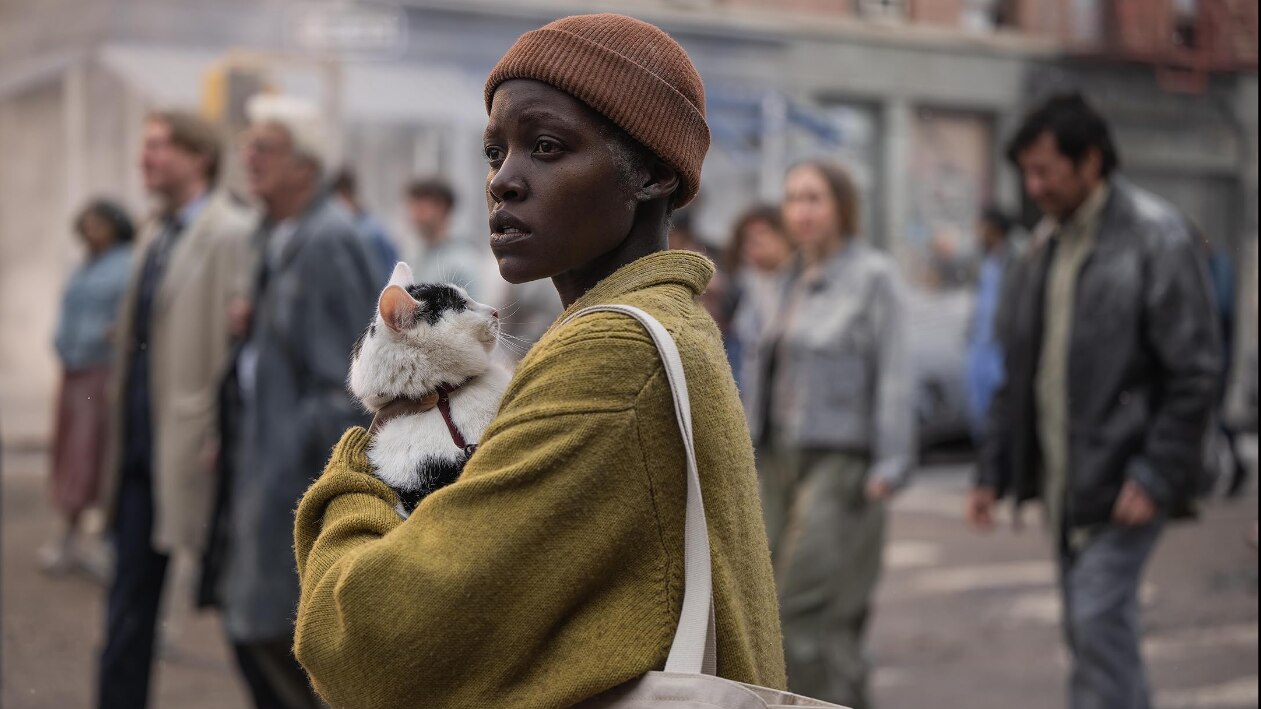
A QUIET PLACE: DAY ONE STARS LUPITA NYONG'O AND FRODO THE CAT AS WE JOURNEY BACK TO WHERE THE HORRORS GOT STARTED
In the spirit of A Nightmare on Elm Street, Harry Potter and The Lord of the Rings, A Quiet Place has become one of those rare film series whose third instalment may well be its strongest.
The last two films were certainly no slouch. Helmed by John Krasinski in an unexpected flex of horror filmmaking chops, they depicted a world ravaged by extraterrestrial monsters with a serious sensitivity to sound.
Both movies remain a marvel of economy in transposing their simple gimmick into not just a variety of inventive set-pieces (infamously instilling audiences with a fear of upturned nails), but a keenly felt evocation of grief hanging over its family of survivors.
As its title suggests, A Quiet Place: Day One winds the clock back to the initial alien incursion in New York, revealing the city-wide devastation that previously hid just out of frame. The Kransinski-Blunt power couple are jettisoned in favour of Lupita Nyong'o's Sam, a terminal cancer patient whose days are already numbered; when she takes a day trip away from her hospice facility, she finds herself stranded at ground zero for the apocalypse.
The expanded scope of this prequel inevitably results in familiar iconography of ravaged skylines and cascading rubble, with wider shots depicting New York as a jungle gym for the series' athletic antagonists. At four times the budget of the first film, there's a pronounced sense of the series exceeding its no-nonsense minimalist roots, especially at a time when city-levelling spectacle feels eerily passé.
It's no small feat, then, that Day One remains firmly grounded in its emotional stakes. Sam offers a refreshing POV for the genre as a protagonist focused on ending life on her own terms, rather than forging a new future.
Having already proved her scream queen credentials with Jordan Peele's Us, Nyong'o unsurprisingly carries the film. She embodies a palpable exhaustion that convincingly translates into bitterness and belligerence. The near-absence of dialogue results in a showcase for Nyong'o's captivating facial expressions, without which the generically designed monsters would feel half as threatening.
As the remaining populace evacuates to the Hudson River – not unlike the visitors from Shyamalan's Signs, these aliens are surprisingly vulnerable to water – Sam makes a voyage to Harlem for one of the last slices her favourite pizza place will ever make, faithfully accompanied by her tuxedo cat Frodo and fellow straggler Eric (Stranger Things' Joseph Quinn).
To put it lightly, the Quiet Place films have always required some suspension of belief. It is, of course, a questionable idea to haul a meowing machine around New York without being able to so much as crinkle a paper bag, just as it seemed needlessly dangerous for the Krasinskis to have a baby.
But these apparent leaps in logic feel genuinely purposeful, even meaningful. The unconventional focus on Sam's final days crystallises the point that these stories are not just about surviving the end of the world — they're about stubbornly holding onto the things that matter most. People making exclusively rational decisions does not make a compelling movie.
Fortunately for everyone involved, Frodo proves to be an extremely well-behaved boy; his eminent cuteness alone is worth the price of entry.
Taking over from Krasinski, writer-director Michael Sarnoski (Pig) admirably repackages the material into a horror movie that's as soulful as it is scary.
There's an almost Pixar-esque whimsy to the kinship that blossoms between Sam and Eric – relayed through intimate whispers, glances and physical touch – as they mourn the remnants of their city and seek out a pizza slice at the end of the world with an adorable animal sidekick on hand.
Occasionally, the twee-to-terrifying ratio feels unbalanced, particularly when the careful sound design is drowned out by a generic, twinkling score. By the film's final third, there's a nagging feeling that its initial breathless intensity has flagged, devolving into a climax that trades sentimentality for scares with disappointing results.
Day One proves to be the quietest film yet, featuring long stretches of silence suffused with a pronounced, visceral intensity. Where silence once conveyed an inability to process personal loss, it now underscores the horror of bearing witness to colossal tragedy.
An early sequence patiently tracks trembling civilians tending to injuries, sobs tightly wound in chests. Later, an evacuation order sees masses of survivors hobbling through the streets to safety, where the mounting sound of each footstep and breath threatens to spill over into disaster.
A heavy rainstorm provides momentary relief for Sam and Eric, who subsequently unleash the series' most cathartic screams; not since the first Twilight movie have the crackles of a thunderstorm been put to such memorable use.
The premise of this series is so fundamentally threadbare – most horror films implicitly treat sound as a death sentence – it's impressive that it's managed to expand beyond a single movie.
Sarnoski's prequel is inventive enough to suggest that, in the right pair of hands, this unlikely franchise may yet have some mileage.
A Quiet Place: Day One is in cinemas now.